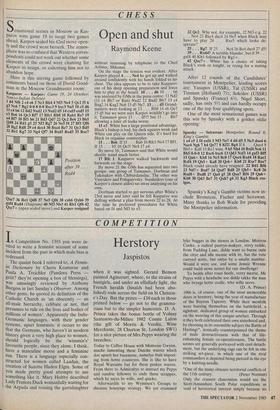CHESS
Sensational scenes in Moscow as Kas- parov wins game 19 to surge two games ahead. Karpov sealed his 42nd move open- ly and the crowd went berserk. The atmos- phere was so confused that Western corres- pondents could not work out whether some elements of the crowd were chanting for Karpov to resign, or exhorting him not to abandon hope. Here is this stirring game followed by Comments based on those of David Good- man in the Moscow Grandmaster room: Kasparov — Karpov: Game 19, 24 October; Nimzo-Indian Defence.
1 d4 Nf6 2 c4 e6 3 Nc3 Bb4 4 Nf3 Ne4 5 Qc2 f5 6 g3 Nc6 7 Bg2 0.0 8 0-0 Bxc3 9 bxc3 Na5 10 c5 d6 11 c4 b6 12 Bd2 Nxd2 13 Nxd2 d5 14 cxd5 exd5 15 e3 Be6 16 Qc3 Rf7 17 Rfcl Rb8 18 Rabl Re7 19 a4 817 20 Bfl h6 21 Bd3 Qd7 22 Qc2 Be6 23 Bb5 Qd8 24 Rdl g5 25 Nf3 Rg7 26 Ne5 f4 27 Bfl Qf6 28 Bg2 Rd8 29 e4 dex4 30 Bxc4 Re7 31 Qc3 Bd5 32 Rel Kg7 33 Ng4 Qf7 34 BxdS RxdS 35 Rxe7
Position after 39 . . . Rxd4 Qxe7 36 Rel Qd8 37 Ne5 Qf6 38 cxb6 Qxb6 39 gxf4 Rxd4 (Diagram) 40 N13 Nb3 41 Rb1 Qf6 42 Qxc7+ (open sealed move) and Karpov resigned
Open and shut
Raymond Keene
without resuming by telephone to the Chief Arbiter, Mikenas.
On the stage the tension was evident. After Karpov played 4 . . . Ne4 he got up and walked around confidently with his hands folded to his chest. The idea appears to be to take Kasparov out of his deep opening preparation and force him to play at the board. 10 . . . d6 10 . . b6 was analysed by GMs in the press centre: 11 Nd2 (11 c4 Bb7 or Ba6) Nxd2 12 Bxd2 Bb7 13 c4 Bxg2 14 Kxg2 Nc6 15 d5 Ne7. 13 . . . d5 Grand- masters were looking at 13 . . . Rb8 14 c6 Qe7 15 d5 but we were sure Karpov wouldn't go into it. Taimanov gives 13 . . . d5?! but 13 . . . Bb7 allowing a later c6 looks worse. 15 e3. White has a large positional advantage. Black's bishop is bad, his dark squares weak and White can play on the Queen side. It's hard for Black to organise counterplay. 15 . . . Be6. If 15 . . . Ba6 16 Rfcl Nc4 17 Bfl. If 15 . . . b5 16 Qc3! Nc4 17 a4.
By move 16, Taimanov said that White would shortly stand much better.
17 Rfc 1. Kasparov walked backwards and forwards on the stage.
By move 21 the GMs has separated into two groups: one group of Taimanov, Dorfman and Tukmakov with Chiburdanidze. The other was Vasyukov and Polugaievsky. Sveshnikov (one of Karpov's closest aides) sat away analysing on his own.
Dorfman started to get nervous after White's 23rd move and later said he felt Kasparov was drifting without aplan from moves 22 to 28. At the time he preferred procedures for White based on f4 and Nf3 to e5.
22 Qc2. Why not, for example, 22 Nf3 e.g. 22
. . Nc4 23 Bxc4 dxc4 24 Ne5 when Black may have to play 24 . . . RxeS which looks de- sperate?
25 . . . Rg7. If 25 . . . Nc4 26 Bc4 dxc4 27 d5! 39 . . . Rxd4? A terrible blunder, but if 39 . . . gxf4 40 Kh1 followed by Rgl +. 42 Qxc7+. White has a choice of taking Black's rook or knight, or trying for a mating attack.
After 12 rounds of the Candidates' tournament in Montpelier, leading scores are: Yusupov (USSR), Tal (USSR) and Timman (Holland) 71/2; Sokolov (USSR) and Spassky (France) 61/2. Nigel Short, sadly, has only 51/2 and can hardly occupy one of the top four qualifying spots.
One of the most sensational games was this win by Spassky with a golden oldie opening: Spassky — Seirawan: Montpelier, Round 9; King's Gambit. 1 e4 e5 2 f4 exf4 3 Nf3 Ne7 4 d4 d5 5 Nc3 dxe4 6 Nxe4 Ng6 7 h4 Qe7? 8 Kf2! Bg4 If 8 . • . Qxe4 9 Bb5+ Kd8 10 Rel wins. 9 h5 Nh4 10 Bxf 4 Nc6 11 Bb5 0-0-0 12 Bxc6 bxc6 13 Qd3 Nxf3 14 gxf3 Bf5 15 Qa6+ Kb8 16 Nc5 Bc8 17 Qxc6 Rxd4 18 Rael Rxf4 19 Qb5+ Ka8 20 Qc6+ Kb8 21 Rxe7 Bxe7 Black could already have resigned. 22 Rdl Rf6 23 Nd7+ Bxd7 24 Qxd7 Rd8 25 Qb5+ Kc8 26 Rxd8+ BxdS 27 Qa4 g5 28 Qxa7 Rf4 29 Qa6+ Kb8 30 Qd3 Be7 31 Qxh7 g4 32 Kg3 Black res- igns.
Spassky's King's Gambit victims now in- clude Bronstein, Fischer and Seirawan. Many thanks to Bob Wade for providing the Montpelier information.






















































 Previous page
Previous page